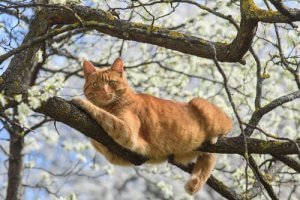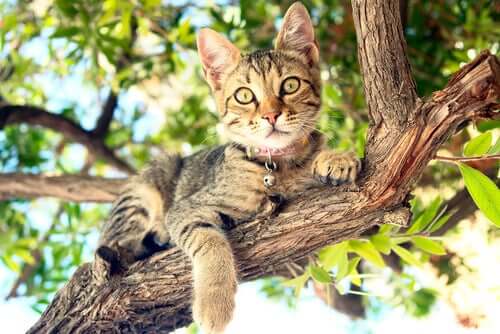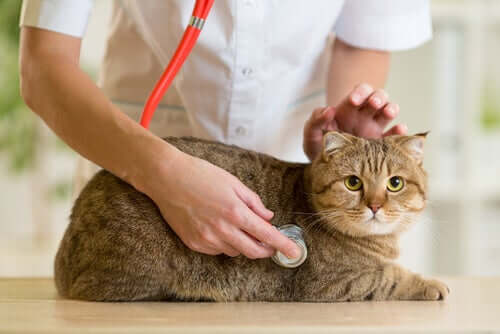How to Help a Cat Who Has Fallen From a Height

People say that cats have 9 lives. Considering their curious nature, it’s no surprise to see them clambering up trees or on rooftops, or sometimes falling off them. This article will explain how you can help cats who have fallen from a height, which is undoubtedly one of the more common accidents to happen to a cat.
Cats at height

Although we’re not quite sure why, there’s no denying that cats love to clamber up high. Some say that this is due to their hunting instinct. Others say it’s down to their curiosity, their lack of fear of heights or because some love to play and chase dogs. There’s no denying that their slim and flexible bodies allow them to climb anywhere.
Their extraordinary ability to walk away from falls uninjured has created this myth that cats “have 9 lives”. They fall from heights so often that vets have started calling these types of accident cases “high-rise syndrome”.
These accidents usually involve kittens or children, given that they’re more curious, more daring… and more inexperienced. From a young age, they go out into the world and find the most dangerous surfaces and areas to play their games and let their adventures unfold.
However, during their adolescent years (when sex starts to become a bigger part of their lives), they become more prone to falls again, especially the males. When they can smell a female’s hormones, the thought of any danger quickly leaves their minds. When they’re following a scent, they can end up in unreachable places and risk a fall.
Adult cats fall less frequently. In most cases, the falls are caused by issues with the nervous system, general weakness, bone or muscular problems, or an issue with balance.
How can you help a cat who has fallen from a height?
There can be several reasons why a cat falls. If the cat keeps falling, it’s important to call a vet so that they can check them over. The vet can also advise what treatment is best for a case of high-rise syndrome.
If the vet doesn’t find any medical issues, then the falls are likely caused by the cat’s behavior or habits. Perhaps the cat became used to clambering up trees or roofs when they were small. It would therefore be even harder to take away the joy the cat feels when climbing, even though they keep falling.
When taking care of a cat who has fallen from a height, it’s best to:
-
Avoid giving them any painkillers or other medicine intended for humans
Many people make the mistake of trying to treat their own pets. However, human medicine can poison animals, even in small doses.
-
Keep them still
This might be difficult with cats that won’t keep still for even a minute. A cat who has fallen from a height and is hurt can become dangerous or may even bite or scratch you. Make sure you handle them as carefully as you can. That way, they won’t be frightened, and they’ll let you care for them.
-
Take them to the vet

It might seem that your cat is not seriously hurt, but some injuries are not visible to the human eye. A vet will be able to check your cat out, diagnose their symptoms and do a couple of tests. These will make sure that they haven’t broken any bones or have any internal injuries. These could include injuries to the lungs, for example, which are quite sensitive in cats.
-
Monitor their behavior
If your cat has fallen and you realize that they aren’t moving as normal, or they’re keeping still, then get them to the vet as soon as possible. For example, they might have hidden under the bed or the table, they might be meowing all the time or not want to eat. These are signs that your cat could have internal damage or be injured.
-
Take precautions
If you own a cat that loves to climb, then it’s recommended that you close any windows, balcony doors or vents to keep them safe. You could also give them toys to keep them entertained or provide platforms that allow them to jump to different places without them falling and hurting themselves.
People say that cats have 9 lives. Considering their curious nature, it’s no surprise to see them clambering up trees or on rooftops, or sometimes falling off them. This article will explain how you can help cats who have fallen from a height, which is undoubtedly one of the more common accidents to happen to a cat.
Cats at height

Although we’re not quite sure why, there’s no denying that cats love to clamber up high. Some say that this is due to their hunting instinct. Others say it’s down to their curiosity, their lack of fear of heights or because some love to play and chase dogs. There’s no denying that their slim and flexible bodies allow them to climb anywhere.
Their extraordinary ability to walk away from falls uninjured has created this myth that cats “have 9 lives”. They fall from heights so often that vets have started calling these types of accident cases “high-rise syndrome”.
These accidents usually involve kittens or children, given that they’re more curious, more daring… and more inexperienced. From a young age, they go out into the world and find the most dangerous surfaces and areas to play their games and let their adventures unfold.
However, during their adolescent years (when sex starts to become a bigger part of their lives), they become more prone to falls again, especially the males. When they can smell a female’s hormones, the thought of any danger quickly leaves their minds. When they’re following a scent, they can end up in unreachable places and risk a fall.
Adult cats fall less frequently. In most cases, the falls are caused by issues with the nervous system, general weakness, bone or muscular problems, or an issue with balance.
How can you help a cat who has fallen from a height?
There can be several reasons why a cat falls. If the cat keeps falling, it’s important to call a vet so that they can check them over. The vet can also advise what treatment is best for a case of high-rise syndrome.
If the vet doesn’t find any medical issues, then the falls are likely caused by the cat’s behavior or habits. Perhaps the cat became used to clambering up trees or roofs when they were small. It would therefore be even harder to take away the joy the cat feels when climbing, even though they keep falling.
When taking care of a cat who has fallen from a height, it’s best to:
-
Avoid giving them any painkillers or other medicine intended for humans
Many people make the mistake of trying to treat their own pets. However, human medicine can poison animals, even in small doses.
-
Keep them still
This might be difficult with cats that won’t keep still for even a minute. A cat who has fallen from a height and is hurt can become dangerous or may even bite or scratch you. Make sure you handle them as carefully as you can. That way, they won’t be frightened, and they’ll let you care for them.
-
Take them to the vet

It might seem that your cat is not seriously hurt, but some injuries are not visible to the human eye. A vet will be able to check your cat out, diagnose their symptoms and do a couple of tests. These will make sure that they haven’t broken any bones or have any internal injuries. These could include injuries to the lungs, for example, which are quite sensitive in cats.
-
Monitor their behavior
If your cat has fallen and you realize that they aren’t moving as normal, or they’re keeping still, then get them to the vet as soon as possible. For example, they might have hidden under the bed or the table, they might be meowing all the time or not want to eat. These are signs that your cat could have internal damage or be injured.
-
Take precautions
If you own a cat that loves to climb, then it’s recommended that you close any windows, balcony doors or vents to keep them safe. You could also give them toys to keep them entertained or provide platforms that allow them to jump to different places without them falling and hurting themselves.
All cited sources were thoroughly reviewed by our team to ensure their quality, reliability, currency, and validity. The bibliography of this article was considered reliable and of academic or scientific accuracy.
- High-Rise Syndrome in Cats, ASPCA. Recogido a 4 de enero de 2022 en https://www.aspcapetinsurance.com/resources/high-rise-syndrome-in-cats/
- First Aid for Falls in Cats, VCA Hospitals. Recogido a 4 de enero de 2022 en https://vcahospitals.com/know-your-pet/first-aid-for-falls-in-cats
- Umphlet, R. C., & Johnson, A. L. (1988). Mandibular fractures in the cat a retrospective study. Veterinary Surgery, 17(6), 333-337.
- Vnuk, D., Pirkić, B., Matičić, D., Radišić, B., Stejskal, M., Babić, T., … & Lemo, N. (2004). Feline high-rise syndrome: 119 cases (1998–2001). Journal of feline medicine and surgery, 6(5), 305-312.
- Bonner, S. E., Reiter, A. M., & Lewis, J. R. (2012). Orofacial manifestations of high-rise syndrome in cats: a retrospective study of 84 cases. Journal of veterinary dentistry, 29(1), 10-18.
- Lefman, S., & Prittie, J. E. High‐rise syndrome in cats and dogs. Journal of Veterinary Emergency and Critical Care.
- Merbl, Y., Milgram, J., Moed, Y., Bibring, U., Peery, D., & Aroch, I. (2013). Epidemiological, clinical and hematological findings in feline high rise syndrome in Israel: a retrospective case-controlled study of 107 cats. Israel Journal of Veterinary Medicine, 68(1), 28-37.
- Liehmann, L. M., Dörner, J., Hittmair, K. M., Schwendenwein, I., Reifinger, M., & Dupré, G. (2012). Pancreatic rupture in four cats with high-rise syndrome. Journal of feline medicine and surgery, 14(2), 131-137.
This text is provided for informational purposes only and does not replace consultation with a professional. If in doubt, consult your specialist.








